Synergistic Enhancement of Chemiresistive NO2 Gas Sensors Using Nitrogen-Doped Reduced Graphene Oxide (N-rGO) Decorated with Nickel Oxide (NiO) Nanoparticles: Achieving sub-ppb Detection Limit
Abstract
1. Introduction
2. Materials and Methods
2.1. Synthesis of Materials
2.2. Preparation of Sensors
2.3. Gas Sensing Measurements
2.4. Material Characterization
3. Results
3.1. Characterization
3.2. Gas Sensing Characterization
4. Discussion
5. Conclusions
Supplementary Materials
Author Contributions
Funding
Institutional Review Board Statement
Informed Consent Statement
Data Availability Statement
Conflicts of Interest
References
- Salonen, H.; Salthammer, T.; Morawska, L. Human Exposure to NO2 in School and Office Indoor Environments. Environ. Int. 2019, 130, 104887. [Google Scholar] [CrossRef] [PubMed]
- Manisalidis, I.; Stavropoulou, E.; Stavropoulos, A.; Bezirtzoglou, E. Environmental and Health Impacts of Air Pollution: A Review. Front. Public Health 2020, 8, 14. [Google Scholar] [CrossRef] [PubMed]
- Mei, H.; Zhang, F.; Zhou, T.; Zhang, T. Pulse-Driven MEMS NO2 Sensors Based on Hierarchical In2O3 Nanostructures for Sensitive and Ultra-Low Power Detection. Sensors 2024, 24, 7188. [Google Scholar] [CrossRef] [PubMed]
- Recum, P.; Hirsch, T. Graphene-Based Chemiresistive Gas Sensors. Nanoscale Adv. 2024, 6, 11–31. [Google Scholar] [CrossRef]
- Sharma, A.; Eadi, S.B.; Noothalapati, H.; Otyepka, M.; Lee, H.-D.; Jayaramulu, K. Porous Materials as Effective Chemiresistive Gas Sensors. Chem. Soc. Rev. 2024, 53, 2530–2577. [Google Scholar] [CrossRef]
- Ma, J.; Zhang, M.; Dong, L.; Sun, Y.; Su, Y.; Xue, Z.; Di, Z. Gas Sensor Based on Defective Graphene/Pristine Graphene Hybrid towards High Sensitivity Detection of NO2. AIP Adv. 2019, 9, 075207. [Google Scholar] [CrossRef]
- Yuan, W.; Shi, G. Graphene-Based Gas Sensors. J. Mater. Chem. A Mater. 2013, 1, 10078. [Google Scholar] [CrossRef]
- Ghosh, R.; Aslam, M.; Kalita, H. Graphene Derivatives for Chemiresistive Gas Sensors: A Review. Mater. Today Commun. 2022, 30, 103182. [Google Scholar] [CrossRef]
- Walleni, C.; Malik, S.B.; Missaoui, G.; Alouani, M.A.; Nsib, M.F.; Llobet, E. Selective NO2 Gas Sensors Employing Nitrogen- and Boron-Doped and Codoped Reduced Graphene Oxide. ACS Omega 2024, 9, 13028–13040. [Google Scholar] [CrossRef]
- Wang, H.; Maiyalagan, T.; Wang, X. Review on Recent Progress in Nitrogen-Doped Graphene: Synthesis, Characterization, and Its Potential Applications. ACS Catal. 2012, 2, 781–794. [Google Scholar] [CrossRef]
- Ouyang, W.; Zeng, D.; Yu, X.; Xie, F.; Zhang, W.; Chen, J.; Yan, J.; Xie, F.; Wang, L.; Meng, H.; et al. Exploring the Active Sites of Nitrogen-Doped Graphene as Catalysts for the Oxygen Reduction Reaction. Int. J. Hydrogen Energy 2014, 39, 15996–16005. [Google Scholar] [CrossRef]
- Ariharan, A.; Viswanathan, B.; Nandhakumar, V. Nitrogen Doped Graphene as Potential Material for Hydrogen Storage. Graphene 2017, 6, 41–60. [Google Scholar] [CrossRef]
- Shaik, M.; Rao, V.K.; Gupta, M.; Murthy, K.S.R.C.; Jain, R. Chemiresistive Gas Sensor for the Sensitive Detection of Nitrogen Dioxide Based on Nitrogen Doped Graphene Nanosheets. RSC Adv. 2016, 6, 1527–1534. [Google Scholar] [CrossRef]
- Chang, Y.-S.; Chen, F.-K.; Tsai, D.-C.; Kuo, B.-H.; Shieu, F.-S. N-Doped Reduced Graphene Oxide for Room-Temperature NO Gas Sensors. Sci. Rep. 2021, 11, 20719. [Google Scholar] [CrossRef]
- Mirzaei, A.; Bharath, S.P.; Kim, J.-Y.; Pawar, K.K.; Kim, H.W.; Kim, S.S. N-Doped Graphene and Its Derivatives as Resistive Gas Sensors: An Overview. Chemosensors 2023, 11, 334. [Google Scholar] [CrossRef]
- Wang, C.; Yin, L.; Zhang, L.; Xiang, D.; Gao, R. Metal Oxide Gas Sensors: Sensitivity and Influencing Factors. Sensors 2010, 10, 2088–2106. [Google Scholar] [CrossRef]
- Yang, S.; Lei, G.; Xu, H.; Lan, Z.; Wang, Z.; Gu, H. Metal Oxide Based Heterojunctions for Gas Sensors: A Review. Nanomaterials 2021, 11, 1026. [Google Scholar] [CrossRef]
- Masroor, S. Basics of Metal Oxides: Properties and Applications. In Inorganic Anticorrosive Materials; Elsevier: Amsterdam, The Netherlands, 2022; pp. 85–94. [Google Scholar]
- Khomarloo, N.; Mohsenzadeh, E.; Gidik, H.; Bagherzadeh, R.; Latifi, M. Overall Perspective of Electrospun Semiconductor Metal Oxides as High-Performance Gas Sensor Materials for NOx Detection. RSC Adv. 2024, 14, 7806–7824. [Google Scholar] [CrossRef]
- Fine, G.F.; Cavanagh, L.M.; Afonja, A.; Binions, R. Metal Oxide Semi-Conductor Gas Sensors in Environmental Monitoring. Sensors 2010, 10, 5469–5502. [Google Scholar] [CrossRef]
- Ayyala, S.K.; Covington, J.A. Nickel-Oxide Based Thick-Film Gas Sensors for Volatile Organic Compound Detection. Chemosensors 2021, 9, 247. [Google Scholar] [CrossRef]
- Deshpande, M.P.; Patel, K.N.; Gujarati, V.P.; Patel, K.; Chaki, S.H. Structural, Thermal and Optical Properties of Nickel Oxide (NiO) Nanoparticles Synthesized by Chemical Precipitation Method. Adv. Mater. Res. 2016, 1141, 65–71. [Google Scholar] [CrossRef]
- Walleni, C.; Hamdaoui, N.; Malik, S.B.; Nsib, M.F.; Llobet, E. High-Performance Uv Photodetector Based on Nickel Oxide Loaded with Low Amount of Nitrogen and Boron Co-Doped Reduced Graphene Oxide for Bias-Switchable Photoconductance. J. Alloys Compd. 2024, 976, 173248. [Google Scholar] [CrossRef]
- Khaleed, A.A.; Bello, A.; Dangbegnon, J.K.; Madito, M.J.; Ugbo, F.U.; Akande, A.A.; Dhonge, B.P.; Barzegar, F.; Momodu, D.Y.; Mwakikunga, B.W.; et al. Gas Sensing Study of Hydrothermal Reflux Synthesized NiO/Graphene Foam Electrode for CO Sensing. J. Mater. Sci. 2017, 52, 2035–2044. [Google Scholar] [CrossRef]
- Kamal, T. High Performance NiO Decorated Graphene as a Potential H2 Gas Sensor. J. Alloys Compd. 2017, 729, 1058–1063. [Google Scholar] [CrossRef]
- Srirattanapibul, S.; Nakarungsee, P.; Issro, C.; Tang, I.-M.; Thongmee, S. Performance of NiO Intercalated RGO Nanocomposites for NH3 Sensing at Room Temperature. Mater. Sci. Semicond. Process 2022, 137, 106221. [Google Scholar] [CrossRef]
- Shanavas, S.; Ahamad, T.; Alshehri, S.M.; Acevedo, R.; Anbarasan, P.M. A Facile Microwave Route for Fabrication of NiO/RGO Hybrid Sensor with Efficient CO2 and Acetone Gas Sensing Performance Using Clad Modified Fiber Optic Method. Optik 2021, 226, 165970. [Google Scholar] [CrossRef]
- Shanmugasundaram, A.; Chinh, N.D.; Jeong, Y.-J.; Hou, T.F.; Kim, D.-S.; Kim, D.; Kim, Y.-B.; Lee, D.-W. Hierarchical Nanohybrids of B- and N-Codoped Graphene/Mesoporous NiO Nanodisks: An Exciting New Material for Selective Sensing of H 2 S at near Ambient Temperature. J. Mater. Chem. A Mater. 2019, 7, 9263–9278. [Google Scholar] [CrossRef]
- Muzyka, R.; Kwoka, M.; Smędowski, Ł.; Díez, N.; Gryglewicz, G. Oxidation of Graphite by Different Modified Hummers Methods. New Carbon. Mater. 2017, 32, 15–20. [Google Scholar] [CrossRef]
- Xu, C.; Li, Y.; Adams, R.A.; Pol, V.G.; Xiao, Y.; Varma, A.; Chen, P. One-Step Combustion Synthesis of Carbon-Coated NiO/Ni Composites for Lithium and Sodium Storage. J. Alloys Compd. 2021, 884, 160927. [Google Scholar] [CrossRef]
- Li, X.; Zhong, A.; Wei, S.; Luo, X.; Liang, Y.; Zhu, Q. Polyelectrolyte Functionalized Gold Nanoparticles-Reduced Graphene Oxide Nanohybrid for Electrochemical Determination of Aminophenol Isomers. Electrochim. Acta 2015, 164, 203–210. [Google Scholar] [CrossRef]
- Salavati-Niasari, M.; Davar, F.; Fereshteh, Z. Synthesis of Nickel and Nickel Oxide Nanoparticles via Heat-Treatment of Simple Octanoate Precursor. J. Alloys Compd. 2010, 494, 410–414. [Google Scholar] [CrossRef]
- Saikia, J.P.; Paul, S.; Konwar, B.K.; Samdarshi, S.K. Nickel Oxide Nanoparticles: A Novel Antioxidant. Colloids Surf. B Biointerfaces 2010, 78, 146–148. [Google Scholar] [CrossRef] [PubMed]
- Deep Yadav, D.; Jha, R.; Singh, S.; Kumar, A. Synthesis and Characterisation of Nickel Oxide Nanoparticles Using CTAB as Capping Agent. Mater. Today Proc. 2023, 73, 333–336. [Google Scholar] [CrossRef]
- Rochman, R.A.; Wahyuningsih, S.; Ramelan, A.H. Preparation of Nitrogen and Sulphur Co-Doped Reduced Graphene Oxide (RGO-NS) Using N and S Heteroatom of Thiourea. IOP Conf. Ser. Mater. Sci. Eng. 2019, 509, 012119. [Google Scholar] [CrossRef]
- Duan, X.; Indrawirawan, S.; Sun, H.; Wang, S. Effects of Nitrogen-, Boron-, and Phosphorus-Doping or Codoping on Metal-Free Graphene Catalysis. Catal Today 2015, 249, 184–191. [Google Scholar] [CrossRef]
- Beams, R.; Gustavo Cançado, L.; Novotny, L. Raman Characterization of Defects and Dopants in Graphene. J. Phys. Condens. Matter 2015, 27, 083002. [Google Scholar] [CrossRef]
- Dharmaraj, N.; Prabu, P.; Nagarajan, S.; Kim, C.H.; Park, J.H.; Kim, H.Y. Synthesis of Nickel Oxide Nanoparticles Using Nickel Acetate and Poly(Vinyl Acetate) Precursor. Mater. Sci. Eng. B 2006, 128, 111–114. [Google Scholar] [CrossRef]
- Kaschner, A.; Hoffmann, A.; Thomsen, C. Resonant Raman Scattering on Free and Bound Excitons in GaN. Phys. Rev. B 2001, 64, 165314. [Google Scholar] [CrossRef]
- Usharani, N.J.; Bhattacharya, S.S. Effect of Defect States in the Optical and Magnetic Properties of Nanocrystalline NiO Synthesised in a Single Step by an Aerosol Process. Ceram. Int. 2020, 46, 5671–5680. [Google Scholar] [CrossRef]
- Chu, S.-Y.; Wu, M.-J.; Yeh, T.-H.; Lee, C.-T.; Lee, H.-Y. Investigation of High-Sensitivity NO2 Gas Sensors with Ga2O3 Nanorod Sensing Membrane Grown by Hydrothermal Synthesis Method. Nanomaterials 2023, 13, 1064. [Google Scholar] [CrossRef]
- Malik, S.B.; Annanouch, F.E.; D′Souza, R.; Bittencourt, C.; Todorović, M.; Llobet, E. High-Yield WS2 Synthesis through Sulfurization in Custom-Modified Atmospheric Pressure Chemical Vapor Deposition Reactor, Paving the Way for Selective NH3 Vapor Detection. ACS Appl. Mater. Interfaces 2024, 16, 48585–48597. [Google Scholar] [CrossRef] [PubMed]
- Tan, G.; Tang, D.; Wang, X.; He, L.; Mu, T.; Li, G. Preparation of NiO Thin Films and Their Application for NO2 Gas Detection. Int. J. Electrochem. Sci. 2022, 17, 220551. [Google Scholar] [CrossRef]
- Li, J.; Lu, Y.; Ye, Q.; Cinke, M.; Han, J.; Meyyappan, M. Carbon Nanotube Sensors for Gas and Organic Vapor Detection. Nano Lett. 2003, 3, 929–933. [Google Scholar] [CrossRef]
- Verma, R.; Chauhan, M.S.; Pandey, S.; Dandia, A. Reduced Graphene Oxide/NiO Based Nano-Composites for the Efficient Removal of Alizarin Dye, Indigo Dye and Reduction of Nitro Aromatic Compounds. Heliyon 2023, 9, e17162. [Google Scholar] [CrossRef]
- Yan, W.; Worsley, M.A.; Pham, T.; Zettl, A.; Carraro, C.; Maboudian, R. Effects of Ambient Humidity and Temperature on the NO2 Sensing Characteristics of WS2/Graphene Aerogel. Appl. Surf. Sci. 2018, 450, 372–379. [Google Scholar] [CrossRef]
- Song, X.; Li, L.; Chen, X.; Xu, Q.; Song, B.; Pan, Z.; Liu, Y.; Juan, F.; Xu, F.; Cao, B. Enhanced Triethylamine Sensing Performance of α-Fe2O3 Nanoparticle/ZnO Nanorod Heterostructures. Sens. Actuators B Chem. 2019, 298, 126917. [Google Scholar] [CrossRef]
- Bai, H.; Guo, H.; Wang, J.; Dong, Y.; Liu, B.; Xie, Z.; Guo, F.; Chen, D.; Zhang, R.; Zheng, Y. A Room-Temperature NO2 Gas Sensor Based on CuO Nanoflakes Modified with RGO Nanosheets. Sens. Actuators B Chem. 2021, 337, 129783. [Google Scholar] [CrossRef]
- Choudhari, A.; Bhanvase, B.A.; Saharan, V.K.; Salame, P.H.; Hunge, Y. Sonochemical Preparation and Characterization of RGO/SnO2 Nanocomposite: Electrochemical and Gas Sensing Performance. Ceram. Int. 2020, 46, 11290–11296. [Google Scholar] [CrossRef]
- Hoa, L.T.; Tien, H.N.; Luan, V.H.; Chung, J.S.; Hur, S.H. Fabrication of a Novel 2D-Graphene/2D-NiO Nanosheet-Based Hybrid Nanostructure and Its Use in Highly Sensitive NO2 Sensors. Sens. Actuators B Chem. 2013, 185, 701–705. [Google Scholar] [CrossRef]
- Cao, P.; Cai, Y.; Pawar, D.; Navale, S.T.; Rao, C.N.; Han, S.; Xu, W.; Fang, M.; Liu, X.; Zeng, Y.; et al. Down to Ppb Level NO2 Detection by ZnO/RGO Heterojunction Based Chemiresistive Sensors. Chem. Eng. J. 2020, 401, 125491. [Google Scholar] [CrossRef]
- Gomaa, M.M.; Sayed, M.H.; Patil, V.L.; Boshta, M.; Patil, P.S. Gas Sensing Performance of Sprayed NiO Thin Films toward NO2 Gas. J. Alloys Compd. 2021, 885, 160908. [Google Scholar] [CrossRef]
- Jyoti; Varma, G.D. Morphology-Dependent Room Temperature NO2 Detection of CuO Nanostructure/RGO Composites. Appl. Phys. A 2020, 126, 143. [Google Scholar] [CrossRef]
- Wang, Z.; Gao, S.; Fei, T.; Liu, S.; Zhang, T. Construction of ZnO/SnO2 Heterostructure on Reduced Graphene Oxide for Enhanced Nitrogen Dioxide Sensitive Performances at Room Temperature. ACS Sens. 2019, 4, 2048–2057. [Google Scholar] [CrossRef] [PubMed]
- Alouani, M.A.; Casanova-Chafer, J.; de Bernardi-Martín, S.; García-Gómez, A.; Salehnia, F.; Santos-Ceballos, J.C.; Santos-Betancourt, A.; Vilanova, X.; Llobet, E. The Effect of Doping RGO with Nanosized MnO2 on Its Gas Sensing Properties. Chemosensors 2024, 12, 256. [Google Scholar] [CrossRef]
- Adjizian, J.-J.; Leghrib, R.; Koos, A.A.; Suarez-Martinez, I.; Crossley, A.; Wagner, P.; Grobert, N.; Llobet, E.; Ewels, C.P. Boron- and Nitrogen-Doped Multi-Wall Carbon Nanotubes for Gas Detection. Carbon 2014, 66, 662–673. [Google Scholar] [CrossRef]
- Bai, S.; Han, J.; Meng, J.C.; Sun, L.; Sun, J.; Zhao, Y.; Tang, P.; Luo, R.; Li, D.; Chen, A. NiO/ZnO Composite Decorated on RGO for Detection of NO2. Sens. Actuators B Chem. 2021, 339, 129720. [Google Scholar] [CrossRef]
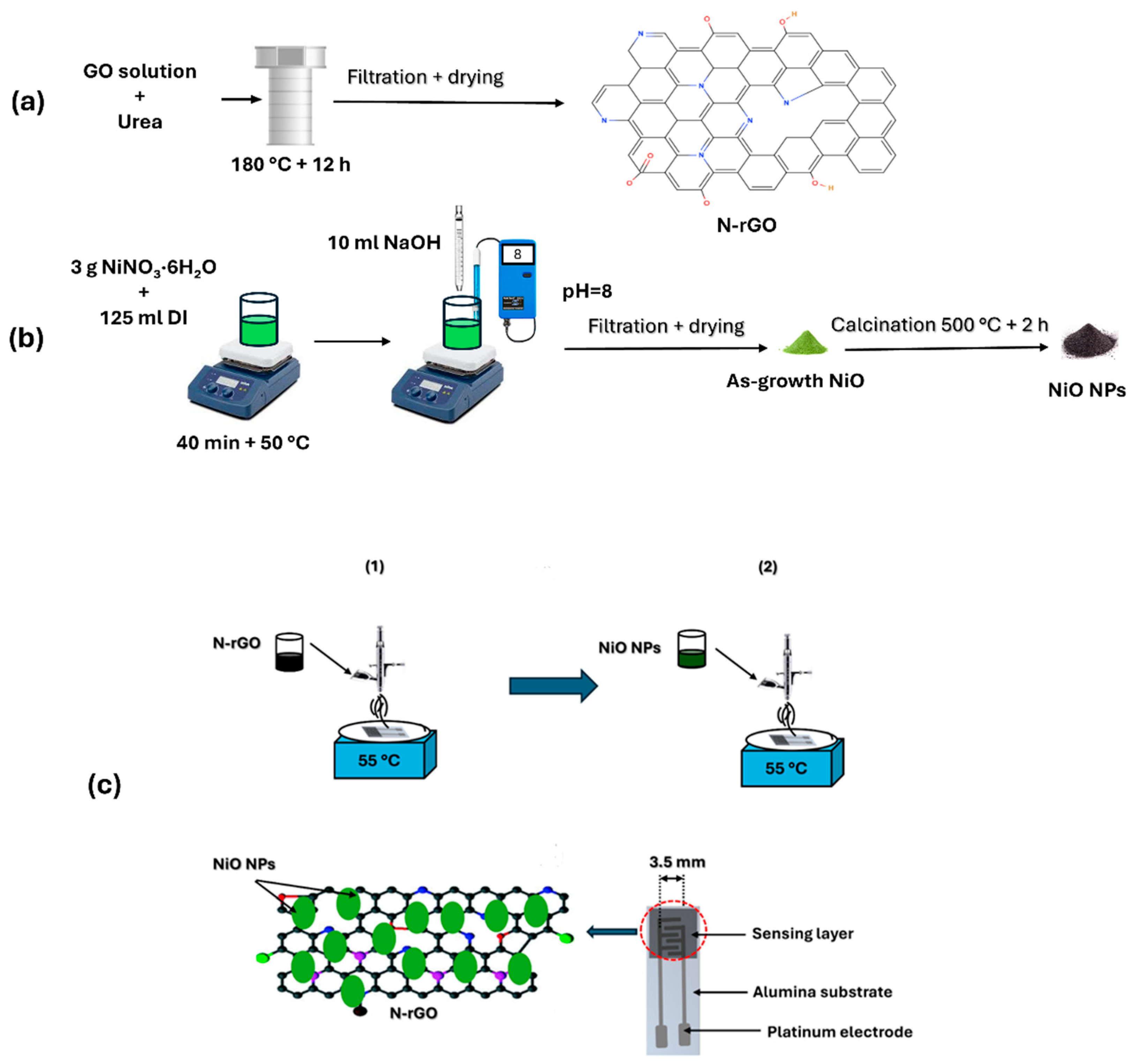
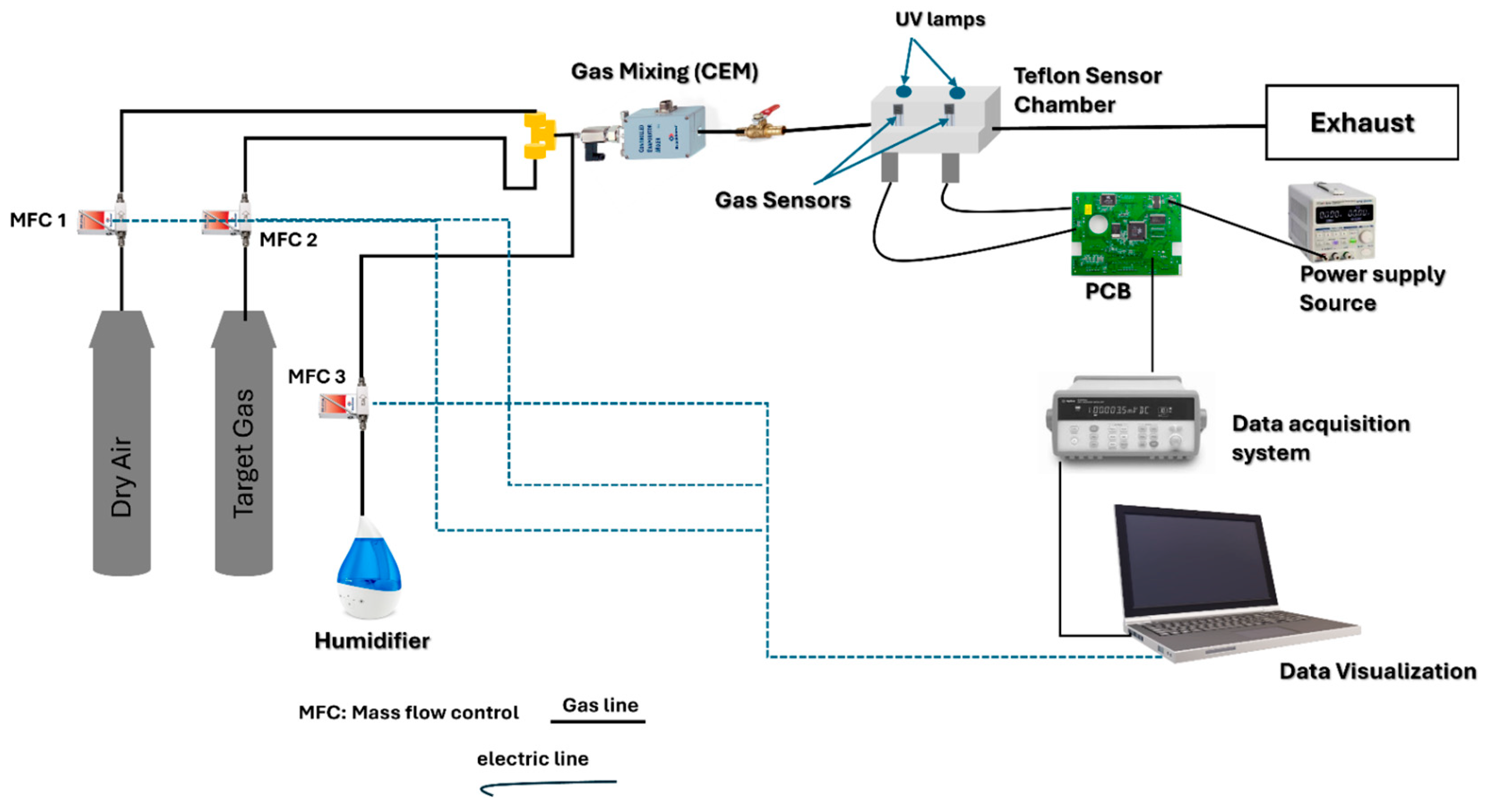
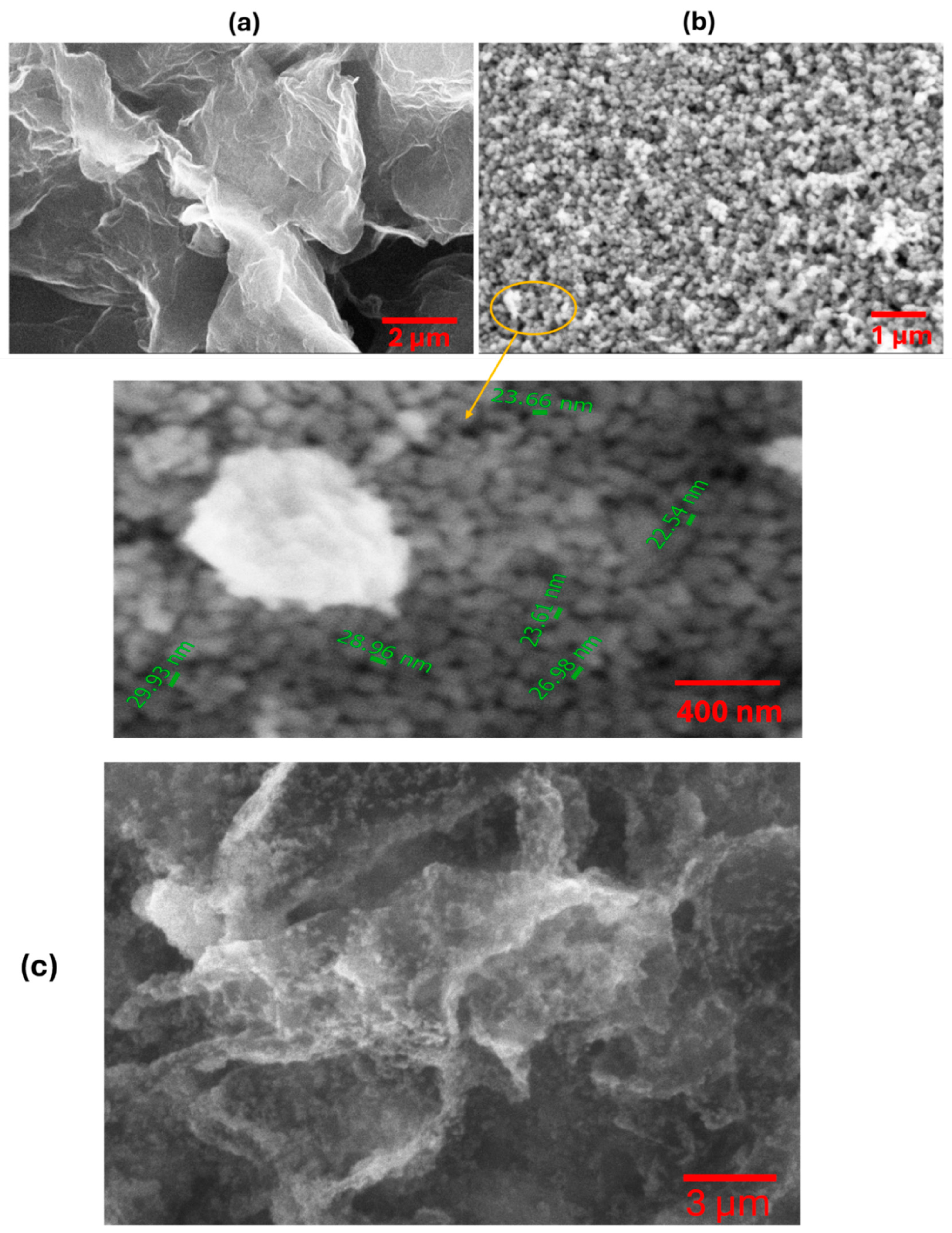
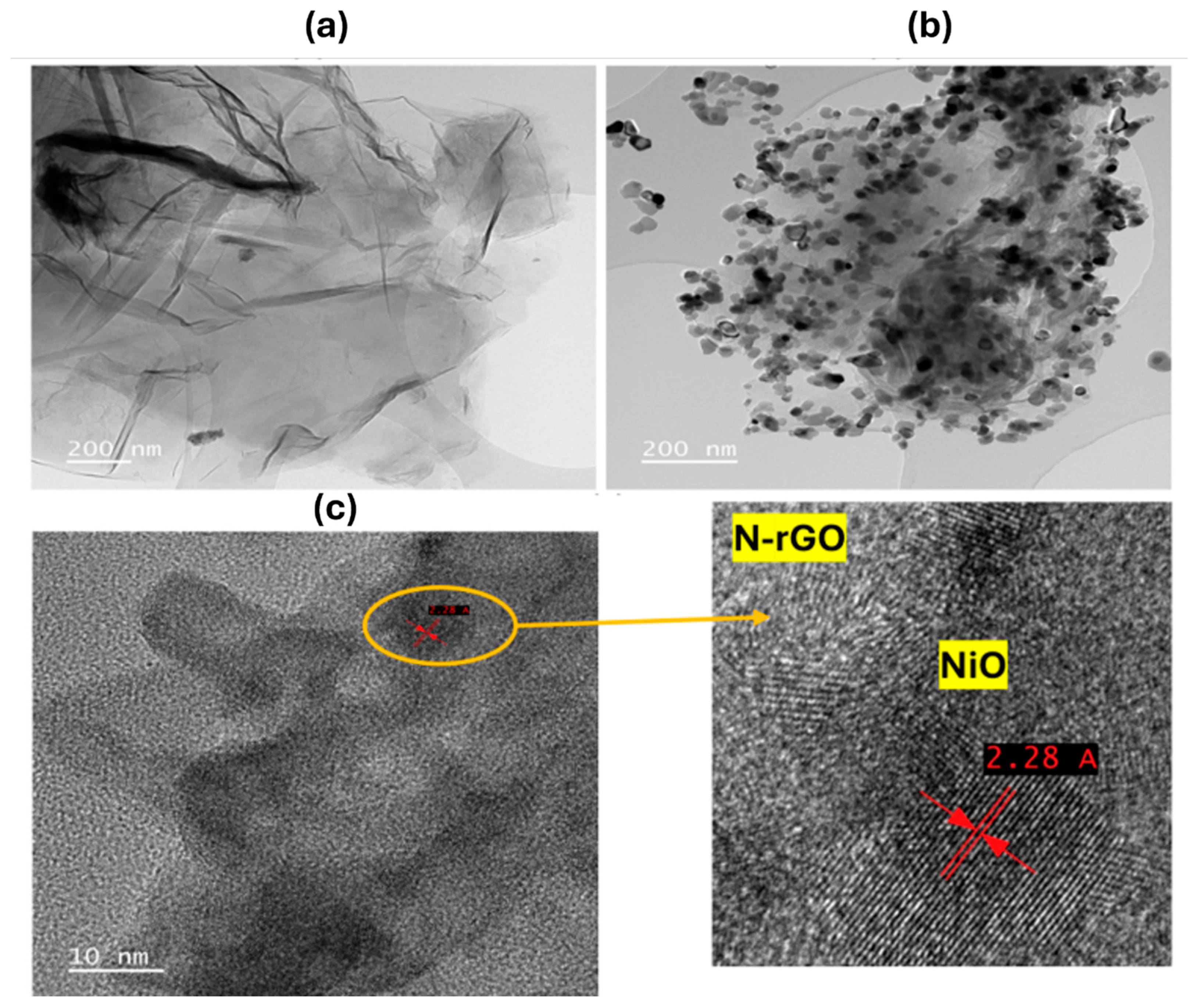
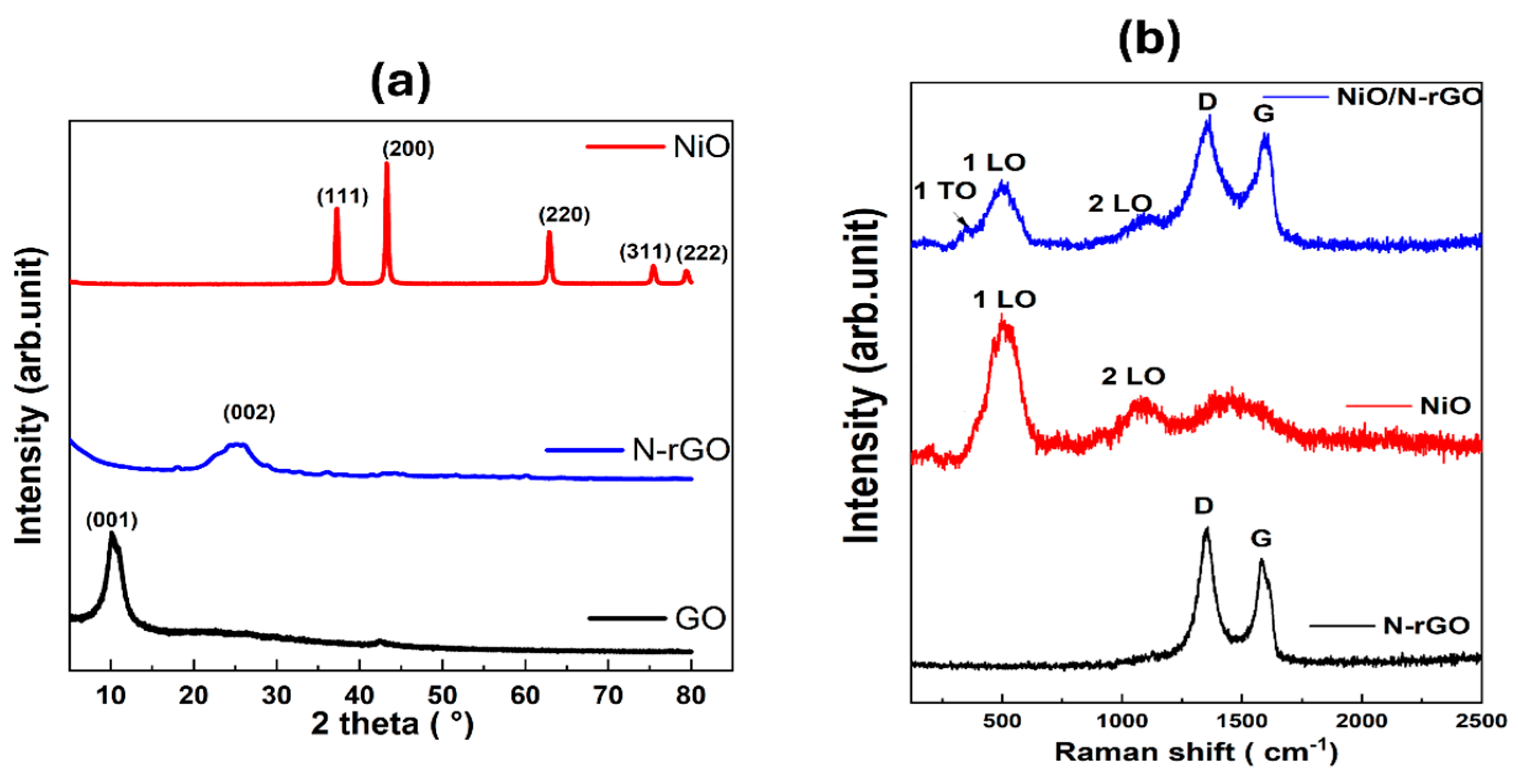


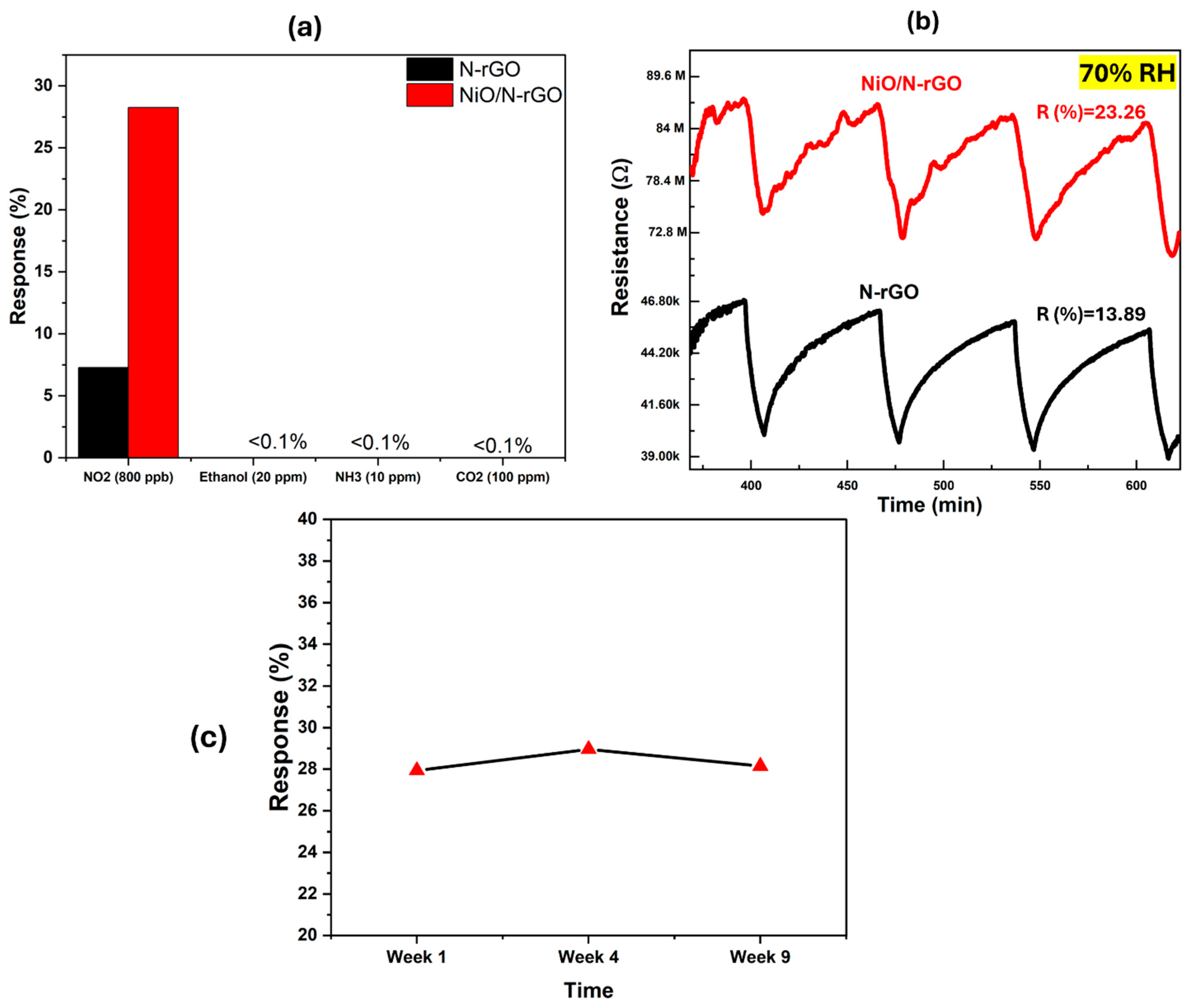

| Sensors | N-rGO | NiO/N-rGO |
|---|---|---|
| Sensitivity (10−2 ppm−1) | 709 | 2398 |
| LoD (ppb) | 39 | <1 |
| Material-Based Sensor | T (°C) | NO2 (ppm) | Response (%) | Tresp/Trec (s) | LOD (ppb) | Ref. |
|---|---|---|---|---|---|---|
| NiO NPs/N-rGO | 100 | 0.8 | 28.25 | 660/2700 | <1 | This work |
| N-rGO | 100 | 0.8 | 7.28 | 600/2640 | 39 | This work |
| SnO2/rGO | 150 | 100 | 97.24 | 14/509 | 1000 | [49] |
| NiO NS/rGO | 200 | 1 | ~670 | - | - | [50] |
| ZnO/rGO | 110 | 2.5 | 33.11 | 182/234 | 5 | [51] |
| NiO Honeycomb | 200 | 20 | 57.3 | - | 20 | [52] |
| CuO/rGO | RT | 20 | 58.1 | 30/- | 1000 | [53] |
| ZnO/SnO2/rGO | RT | 5 | 141 | 33/92 | - | [54] |
Disclaimer/Publisher’s Note: The statements, opinions and data contained in all publications are solely those of the individual author(s) and contributor(s) and not of MDPI and/or the editor(s). MDPI and/or the editor(s) disclaim responsibility for any injury to people or property resulting from any ideas, methods, instructions or products referred to in the content. |
© 2025 by the authors. Licensee MDPI, Basel, Switzerland. This article is an open access article distributed under the terms and conditions of the Creative Commons Attribution (CC BY) license (https://creativecommons.org/licenses/by/4.0/).
Share and Cite
Walleni, C.; Ali, M.B.; Ncib, M.F.; Llobet, E. Synergistic Enhancement of Chemiresistive NO2 Gas Sensors Using Nitrogen-Doped Reduced Graphene Oxide (N-rGO) Decorated with Nickel Oxide (NiO) Nanoparticles: Achieving sub-ppb Detection Limit. Sensors 2025, 25, 1631. https://doi.org/10.3390/s25051631
Walleni C, Ali MB, Ncib MF, Llobet E. Synergistic Enhancement of Chemiresistive NO2 Gas Sensors Using Nitrogen-Doped Reduced Graphene Oxide (N-rGO) Decorated with Nickel Oxide (NiO) Nanoparticles: Achieving sub-ppb Detection Limit. Sensors. 2025; 25(5):1631. https://doi.org/10.3390/s25051631
Chicago/Turabian StyleWalleni, Chiheb, Mounir Ben Ali, Mohamed Faouzi Ncib, and Eduard Llobet. 2025. "Synergistic Enhancement of Chemiresistive NO2 Gas Sensors Using Nitrogen-Doped Reduced Graphene Oxide (N-rGO) Decorated with Nickel Oxide (NiO) Nanoparticles: Achieving sub-ppb Detection Limit" Sensors 25, no. 5: 1631. https://doi.org/10.3390/s25051631
APA StyleWalleni, C., Ali, M. B., Ncib, M. F., & Llobet, E. (2025). Synergistic Enhancement of Chemiresistive NO2 Gas Sensors Using Nitrogen-Doped Reduced Graphene Oxide (N-rGO) Decorated with Nickel Oxide (NiO) Nanoparticles: Achieving sub-ppb Detection Limit. Sensors, 25(5), 1631. https://doi.org/10.3390/s25051631







